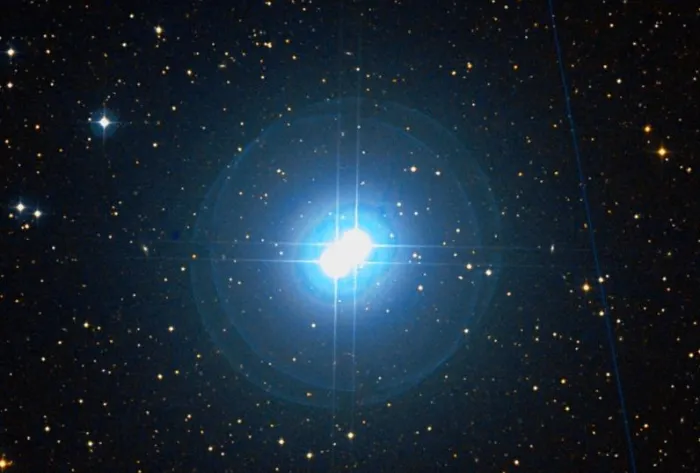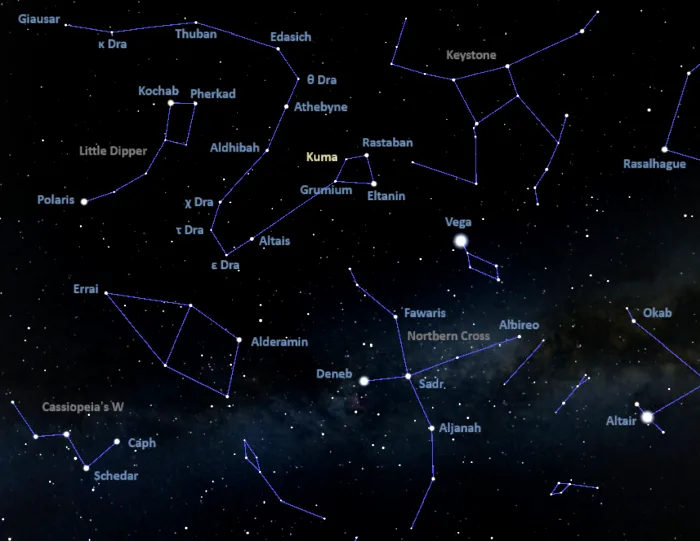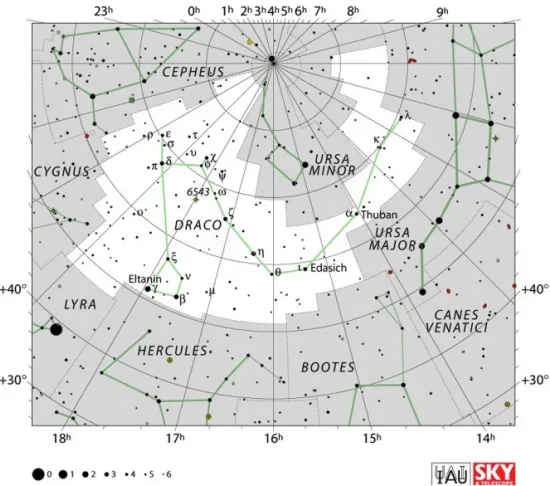Kuma, Nu Draconis (ν Dra), is a multiple star system located approximately 98.7 light-years away in the northern constellation Draco. It has an apparent magnitude of 4.88.
Nu Draconis is one of the four points of light that form the head of the celestial Dragon. It marks the Dragon’s mouth.
Star system
The Nu Draconis system is composed of two visual components, designated Nu1 Draconis and Nu2 Draconis. The components are separated by 62 arcseconds and can be resolved in small binoculars. Nu1 is the western star of the pair. The physical distance between the stars is at least 1,900 AU. The components have an orbital period of at least 44,000 years.
Nu2 Draconis is itself a spectroscopic binary star system with an orbital period of 38.034 days. The two components are separated by 0.267 astronomical units (Earth – Sun distances) on average.
Both Nu1 Draconis and Nu2 Draconis shine at magnitude 4.88. Nu1 Draconis lies 98.7 light-years away and Nu2 Draconis, 99.4 light-years away. In terms of evolutionary stage, both components are main sequence stars.
Nu1 Draconis has the spectral type A8Vm (kA3hF0mF0) and Nu2 Draconis, A4IVm (kA3hF1mF0). The stars are considered to be proper motion companions, even though their orbital motion has not been observed.
Nu1 Draconis and the primary component of Nu2 Draconis are both Am stars (metallic-line stars), chemically peculiar A-type stars with prominent lines of some metals such as zinc, zirconium, strontium and barium and an underabundance of others, such as calcium and scandium.
Nu1 Draconis has a mass of 1.85 solar masses and a radius 1.8 times that of the Sun. With an effective temperature of 7,533 K, it is 8.1 times more luminous than the Sun. It spins at 86 km/s. The star is much younger than the Sun, with an estimated age of 1 billion years.
Nu2 Draconis has 1.61 times the Sun’s mass and a radius of 1.812 solar radii. It has a surface temperature of 7,272 K and a projected rotational velocity of 68 km/s. It is a little older than Nu1 Draconis, with an estimated age of 1.2 billion years. The star has a low-mass companion. The presence of the companion can only be inferred from the orbital motion of the primary component.

Kuma (Nu Draconis), image credit: ESO/Digitized Sky Survey 2 (CC BY 4.0)
Facts
Kuma is the faintest of the four stars that form the Dragon’s head. The other three stars that form the asterism are Eltanin (Gamma Draconis), Rastaban (Beta Draconis), and Grumium (Xi Draconis). Eltanin and Rastaban mark the Dragon’s eyes and Grumium appears in its jaw. The three brighter stars also form an asterism called the Lozenge with Iota Herculis in the neighbouring constellation Hercules.
Nu Draconis was discovered to be a double star by the English astronomer John Flamsteed in 1690. The two visual components were given the Flamsteed designations 24 Draconis and 25 Draconis in Flamsteed’s Atlas Coelestis (1729).
In Arabic astronomy, Kuma was part of an asterism called the Mother Camels (Al ʽAwāyd), along with Eltanin (Gamma Draconis), Rastaban (Beta Draconis), Grumium (Xi Draconis), and Alrakis (Mu Draconis). The stars represented five camels guarding a foal, represented by the faint Alruba (HIP 86782), from two wolves or hyenas, represented by Aldhibah (Zeta Draconis) and Athebyne (Eta Draconis). In Latin, the asterism was known as Quinque Dromedarii, the Five Camels.
In Arabic lore, Kuma also formed a figure known as the Falling Cross (Al Salib al Waki’) with Rastaban (Beta Draconis), Eltanin (Gamma Draconis), Alrakis (Mu Draconis), and Grumium (Xi Draconis).
Name
Nu Draconis is known as Kuma (pronunciation: /ˈkjuːmə/). The origin of the name is uncertain. The name has not been formally approved by the International Astronomical Union (IAU).
In traditional Chinese astronomy, Nu Draconis was known as 天棓二 (Tiān Bàng èr), the Second Star of Celestial Flail. It formed the Celestial Flail asterism with Grumium (Xi Draconis), Rastaban (Beta Draconis), Eltanin (Gamma Draconis), and Iota Herculis. The asterism represented an agricultural device for threshing. It was part of the larger Purple Forbidden Enclosure, which represented the imperial palace.
Location
Kuma is easy to find because it is part of a prominent asterism, the head of Draco. Eltanin and Rastaban, the brighter stars in the Dragon’s head, can be found by extending a line through the beam of the Northern Cross in Cygnus. Kuma appears the farthest of the four stars from the bright Vega in the constellation Lyra.

The location of Kuma (Nu Draconis), image: Stellarium
Constellation
Kuma is located in the circumpolar constellation of Draco. The celestial Dragon is one of the northernmost constellations in the sky. It is circumpolar for observers in the northern hemisphere. It was one of the 48 Greek constellations listed by the Greco-Roman astronomer Claudius Ptolemy of Alexandria in his Almagest in the 2nd century AD. In Greek mythology, the constellation is associated with the dragon Ladon, who guarded the gardens of the Hesperides.
Draco stretches across 1,083 square degrees of the northern celestial hemisphere and is the eighth largest of the 88 constellations. It is the fourth largest northern constellation, after Ursa Major, Hercules, and Pegasus.
However, Draco is not exceptionally bright. The constellation’s lucida, the orange giant star Eltanin (Gamma Draconis), has an apparent visual magnitude of 2.23. It has more than double the Sun’s mass and is almost 600 times more luminous.

Draco constellation map by IAU and Sky&Telescope magazine (Roger Sinnott & Rick Fienberg) (CC BY 3.0)
Other relatively bright stars in the constellation include the yellow giants Altais (Delta Draconis) and Athebyne (Eta Draconis), the orange giants Grumium (Xi Draconis) and Edasich (Iota Draconis), the yellow bright giant or supergiant Rastaban (Beta Draconis), the white subgiant Thuban (Alpha Draconis), the blue giant Aldhibah (Zeta Draconis), and the multiple star Mu Draconis (Alrakis).
Draco hosts several relatively bright deep sky objects, including the planetary nebula NGC 6543 (the Cat’s Eye Nebula), the lenticular galaxy NGC 5866 (the Spindle Galaxy, Messier 102), and the spiral galaxy NGC 5907 (the Splinter Galaxy). The constellation also contains the interacting pair of galaxies known as the Tadpole Galaxy (Arp 188), the Draco Triplet of galaxies, the Dolphin Galaxy (NGC 6670), and the Draco Dwarf, a satellite galaxy of the Milky Way.
The best time of the year to see the stars and deep sky objects in Draco is during the month of July, when the constellation appears higher in the sky in the early evening. The entire constellation can be seen from locations north of the latitude 15° S.
The 10 brightest stars in Draco are Eltanin (Gamma Dra, mag. 2.23), Athebyne (Eta Dra, mag. 2.73), Rastaban (Beta Dra, mag. 2.79), Altais (Delta Dra, mag. 3.07), Aldhibah (Zeta Dra, mag. 3.17), Edasich (Iota Dra, mag. 3.29), Chi Draconis (mag. 3.57), Thuban (Alpha Dra, mag. 3.6452), Grumium (Xi Dra, mag. 3.75), and Giausar (Lambda Dra, mag. 3.85).
Kuma – Nu Draconis
| Spectral class | A8Vm (kA3hF0mF0) + A4IVm (kA3hF1mF0) |
| Apparent magnitude | 4.88 |
| Constellation | Draco |
| Right ascension | 17h 32m 13.0s |
| Declination | +55° 10′ 42′′ |
| Names and designations | Kuma, Nu Draconis, Nu Dra, ν Draconis, ν Dra, IRAS 17312+5512, IRAS F17312+5512, PMSC 17303+5514, CCDM J17322+5511AB, STF 4035, WDS J17322+5511AB |
Nu1 Draconis
| Spectral class | A8Vm (kA3hF0mF0) |
| U-B colour index | +0.03 |
| B-V colour index | +0.26 |
| Apparent magnitude | 4.88 |
| Distance | 98.7 ± 0.4 light-years (30.2 ± 0.1 parsecs) |
| Parallax | 33.2097 ± 0.0887 mas |
| Radial velocity | -15.20 ± 1.78 km/s |
| Proper motion | RA: +148.040 ± 0.099 mas/yr |
| Dec.: +54.194 ± 0.136 mas/yr | |
| Mass | 1.85 M☉ |
| Luminosity | 8.1 L☉ |
| Radius | 1.8 R☉ |
| Temperature | 7,533 K |
| Metallicity | +0.03 |
| Age | 1.0 billion years |
| Rotational velocity | 86 km/s |
| Surface gravity | 4.2 cgs |
| Right ascension | 17h 32m 10.5682505040s |
| Declination | +55° 11′ 03.282550368″ |
| Names and designations | Nu1 Draconis, Nu1 Dra, ν1 Draconis, ν1 Dra, 24 Draconis, 24 Dra, HD 159541, HR 6554, HIP 85819, SAO 30447, FK5 655, JP11 2867, BD+55 1944, AG+55 1099, GC 23797, GCRV 10141, SKY# 31651, PPM 36040, AKARI-IRC-V1 J1732107+551103, GSC 03892-01620, ASCC 199001, Renson 44890, LSPM J1732+5511, ROT 2466, GEN# +1.00159541, N30 3908, PMC 90-93 464, USNO-B1.0 1451-00260067, uvby98 100159541, TIC 229686929, TYC 3892-1620-1, YZ 55 9329, WEB 14483, UBV 14976, UBV M 22277, WISE J173210.72+551103.6, WISEA J173210.76+551103.5, 2MASS J17321055+5511033, Gaia DR2 1420972823028539008, Gaia DR3 1420972823029057408, PMSC 17303+5514B, STF 4035B, ADS 10628 B, CCDM J17322+5511B, IDS 17302+5515 B, WDS J17322+5511B |
Nu2 Draconis
| Spectral class | A4IVm (kA3hF1mF0) |
| U-B colour index | +0.04 |
| B-V colour index | +0.27 |
| Apparent magnitude | 4.88 |
| Distance | 99.4 ± 0.5 light-years (30.5 ± 0.2 parsecs) |
| Parallax | 33.4187 ± 0.1302 mas |
| Radial velocity | -16.0 ± 0.7 km/s |
| Proper motion | RA: +144.339 ± 0.159 mas/yr |
| Dec.: +59.585 ± 0.160 mas/yr | |
| Mass | 1.61 + 0.24 M☉ |
| Radius | 1.812 R☉ |
| Temperature | 7,272 K |
| Age | 1.2 billion years |
| Rotational velocity | 68 km/s |
| Surface gravity | 4.11 cgs |
| Right ascension | 17h 32m 16.0425231528s |
| Declination | +55° 10′ 22.505264940″ |
| Names and designations | Nu2 Draconis, Nu2 Dra, ν2 Draconis, ν2 Dra, 25 Draconis, 25 Dra, HD 159560, HR 6555, HIP 85829, SAO 30450, FK5 657, BD+55 1945, AG+55 1100, GC 23801, GCRV 10143, SKY# 31655, JP11 2869, PPM 36043, PLX 3999.00, ASCC 199005, LSPM J1732+5510, GSC 03892-01621, N30 3909, Renson 44910, USNO-B1.0 1451-00260073, uvby98 100159560, PMC 90-93 466, AKARI-IRC-V1 J1732161+551023, TIC 229686919, GEN# +1.00159560, YZ 55 9330, 2MASS J17321602+5510224, WEB 14485, WISE J173216.21+551023.2, ROT 2467, 1RXS J173216.1+551023, SBC7 628, SBC9 976, UBV 14977, UBV M 22279, TYC 3892-1621-1, Gaia DR2 1420972548150735744, WISEA J173216.21+551023.1, STF 4035A, PMSC 17303+5514A, PMSC 17303+5514Aab, ADS 10628 A, CCDM J17322+5511A, IDS 17302+5515 A, WDS J17322+5511A |